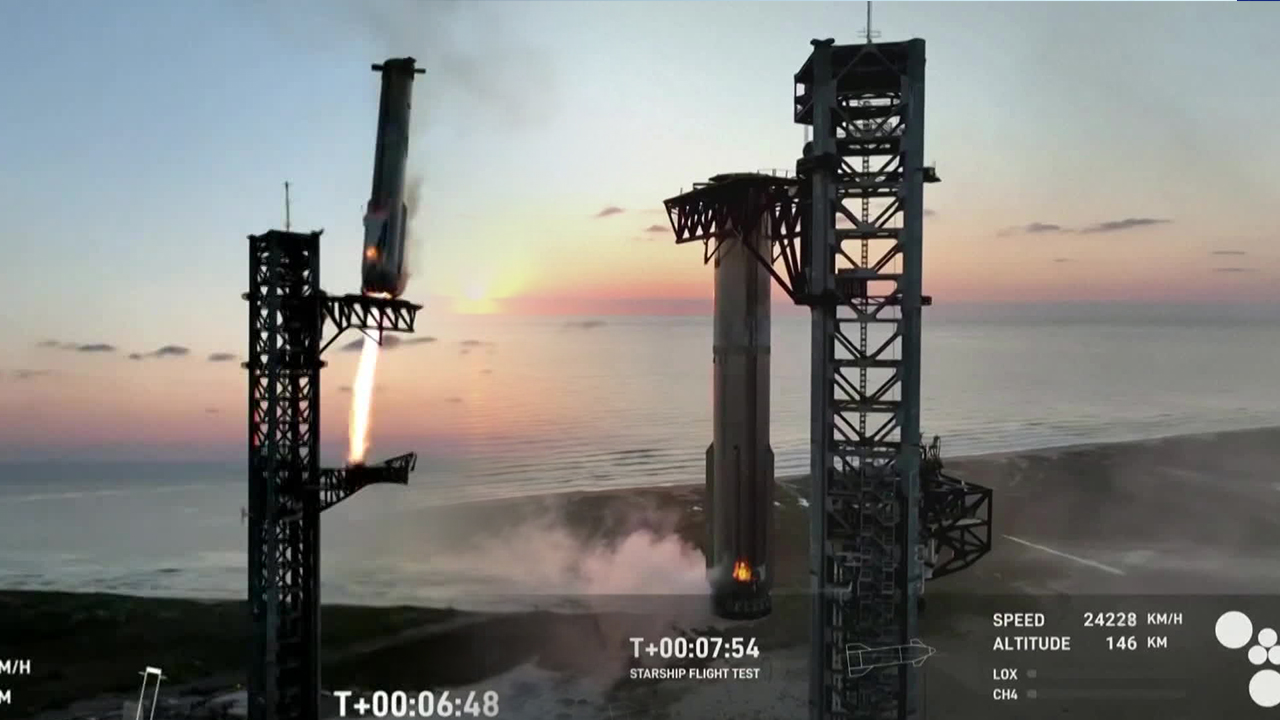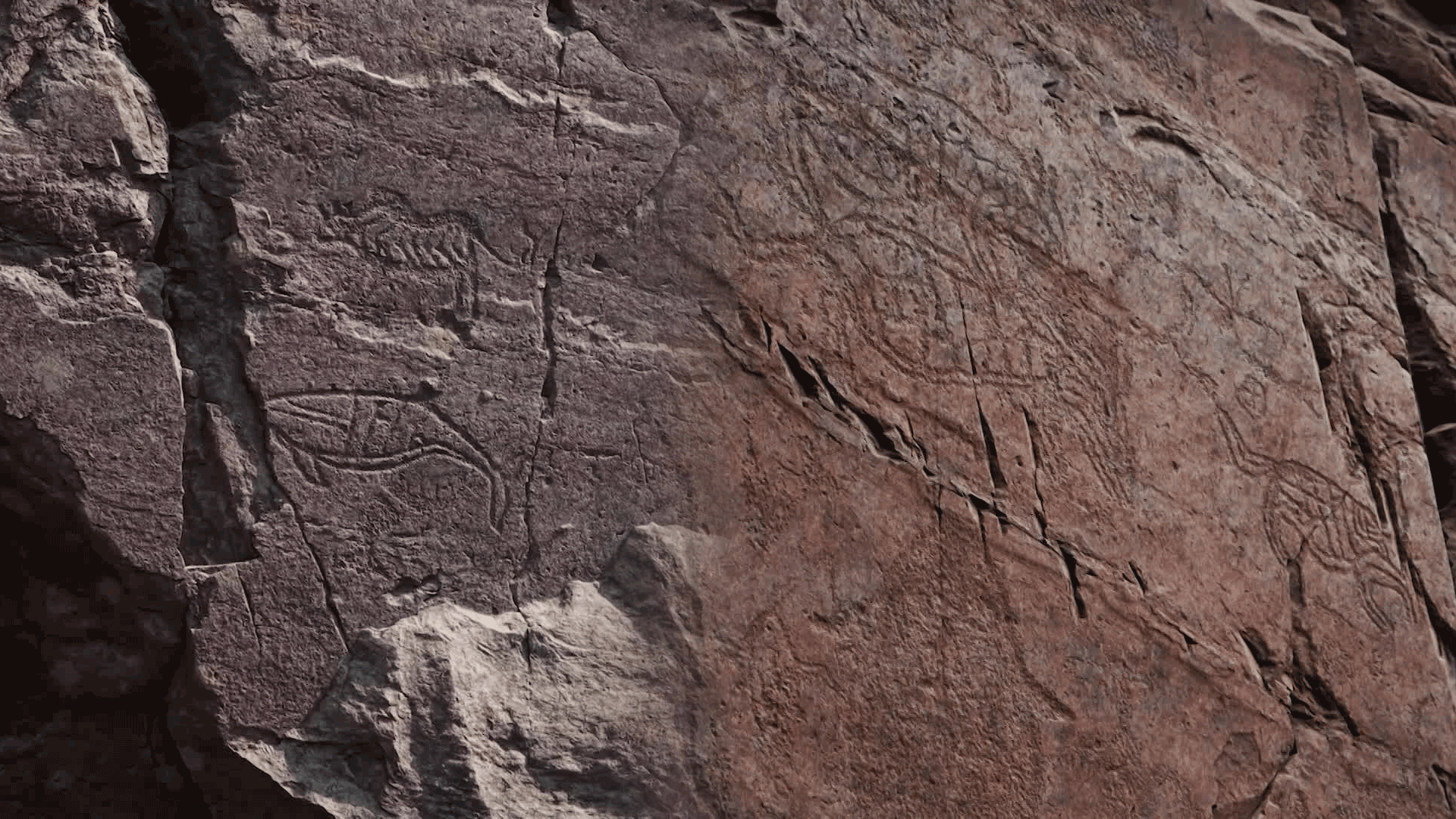Rocket arm successfully catches Super Heavy booster, signaling reusability potential; Elon Musk calls it a big step forward
입력 2024.10.14 (23:57)
읽어주기 기능은 크롬기반의
브라우저에서만 사용하실 수 있습니다.
[Anchor]
This is a launch vehicle created by Elon Musk's space company SpaceX.
The upper part is the spacecraft 'Starship', which has a diameter of 9 meters and a height of 50 meters.
It is the largest spacecraft in history, capable of carrying an astonishing 150 tons ofF people and equipment.
To launch this into space, a powerful booster rocket is needed, and the lower part, 'Super Heavy', is a rocket that stands over 70 meters tall.
With the successful return of this gigantic rocket to the very spot it was launched from, humanity's space development has taken a significant leap forward.
Wi Jae-cheon reports.
[Report]
The private space company SpaceX's spacecraft 'Starship' soars powerfully into the sky.
Three minutes after launch, the first stage rocket, Super Heavy, separates.
It then descends rapidly towards the launch pad.
The Super Heavy, spewing bright red flames, lands precisely on the launch pad's a robotic arm as if it were magnetized, just seven minutes after launch.
This marks the moment humanity successfully recovered the largest rocket ever made.
[Kate Tice/SpaceX Engineer: "This is absolutely insane. On the first ever attempt we have successfully caught the super heavy booster back at the launch tower."]
While the Falcon 9 rocket has been recovered and reused before, recovering a massive rocket with four times the number of engines and ten times the thrust was considered impossible.
However, they succeeded on the first attempt with an ingenious method of capturing the rocket with a robotic arm.
Once the rocket returns to the launch pad, it can be relaunched in just 30 minutes, saving millions of dollars in costs.
[Kate Tice/SpaceX Engineer: "This is a day for the engineering history books."]
The spacecraft Starship also completed its flight of over an hour as scheduled and returned to the sea.
They successfully recovered both the spacecraft and the rocket.
Elon Musk, who has been developing Starship with the goal of Mars exploration, stated through X that "big step towards making life multiplanetary was made today."
KBS News, Wi Jae-cheon.
This is a launch vehicle created by Elon Musk's space company SpaceX.
The upper part is the spacecraft 'Starship', which has a diameter of 9 meters and a height of 50 meters.
It is the largest spacecraft in history, capable of carrying an astonishing 150 tons ofF people and equipment.
To launch this into space, a powerful booster rocket is needed, and the lower part, 'Super Heavy', is a rocket that stands over 70 meters tall.
With the successful return of this gigantic rocket to the very spot it was launched from, humanity's space development has taken a significant leap forward.
Wi Jae-cheon reports.
[Report]
The private space company SpaceX's spacecraft 'Starship' soars powerfully into the sky.
Three minutes after launch, the first stage rocket, Super Heavy, separates.
It then descends rapidly towards the launch pad.
The Super Heavy, spewing bright red flames, lands precisely on the launch pad's a robotic arm as if it were magnetized, just seven minutes after launch.
This marks the moment humanity successfully recovered the largest rocket ever made.
[Kate Tice/SpaceX Engineer: "This is absolutely insane. On the first ever attempt we have successfully caught the super heavy booster back at the launch tower."]
While the Falcon 9 rocket has been recovered and reused before, recovering a massive rocket with four times the number of engines and ten times the thrust was considered impossible.
However, they succeeded on the first attempt with an ingenious method of capturing the rocket with a robotic arm.
Once the rocket returns to the launch pad, it can be relaunched in just 30 minutes, saving millions of dollars in costs.
[Kate Tice/SpaceX Engineer: "This is a day for the engineering history books."]
The spacecraft Starship also completed its flight of over an hour as scheduled and returned to the sea.
They successfully recovered both the spacecraft and the rocket.
Elon Musk, who has been developing Starship with the goal of Mars exploration, stated through X that "big step towards making life multiplanetary was made today."
KBS News, Wi Jae-cheon.
■ 제보하기
▷ 카카오톡 : 'KBS제보' 검색, 채널 추가
▷ 전화 : 02-781-1234, 4444
▷ 이메일 : kbs1234@kbs.co.kr
▷ 유튜브, 네이버, 카카오에서도 KBS뉴스를 구독해주세요!
- Rocket arm successfully catches Super Heavy booster, signaling reusability potential; Elon Musk calls it a big step forward
-
- 입력 2024-10-14 23:57:32

[Anchor]
This is a launch vehicle created by Elon Musk's space company SpaceX.
The upper part is the spacecraft 'Starship', which has a diameter of 9 meters and a height of 50 meters.
It is the largest spacecraft in history, capable of carrying an astonishing 150 tons ofF people and equipment.
To launch this into space, a powerful booster rocket is needed, and the lower part, 'Super Heavy', is a rocket that stands over 70 meters tall.
With the successful return of this gigantic rocket to the very spot it was launched from, humanity's space development has taken a significant leap forward.
Wi Jae-cheon reports.
[Report]
The private space company SpaceX's spacecraft 'Starship' soars powerfully into the sky.
Three minutes after launch, the first stage rocket, Super Heavy, separates.
It then descends rapidly towards the launch pad.
The Super Heavy, spewing bright red flames, lands precisely on the launch pad's a robotic arm as if it were magnetized, just seven minutes after launch.
This marks the moment humanity successfully recovered the largest rocket ever made.
[Kate Tice/SpaceX Engineer: "This is absolutely insane. On the first ever attempt we have successfully caught the super heavy booster back at the launch tower."]
While the Falcon 9 rocket has been recovered and reused before, recovering a massive rocket with four times the number of engines and ten times the thrust was considered impossible.
However, they succeeded on the first attempt with an ingenious method of capturing the rocket with a robotic arm.
Once the rocket returns to the launch pad, it can be relaunched in just 30 minutes, saving millions of dollars in costs.
[Kate Tice/SpaceX Engineer: "This is a day for the engineering history books."]
The spacecraft Starship also completed its flight of over an hour as scheduled and returned to the sea.
They successfully recovered both the spacecraft and the rocket.
Elon Musk, who has been developing Starship with the goal of Mars exploration, stated through X that "big step towards making life multiplanetary was made today."
KBS News, Wi Jae-cheon.
This is a launch vehicle created by Elon Musk's space company SpaceX.
The upper part is the spacecraft 'Starship', which has a diameter of 9 meters and a height of 50 meters.
It is the largest spacecraft in history, capable of carrying an astonishing 150 tons ofF people and equipment.
To launch this into space, a powerful booster rocket is needed, and the lower part, 'Super Heavy', is a rocket that stands over 70 meters tall.
With the successful return of this gigantic rocket to the very spot it was launched from, humanity's space development has taken a significant leap forward.
Wi Jae-cheon reports.
[Report]
The private space company SpaceX's spacecraft 'Starship' soars powerfully into the sky.
Three minutes after launch, the first stage rocket, Super Heavy, separates.
It then descends rapidly towards the launch pad.
The Super Heavy, spewing bright red flames, lands precisely on the launch pad's a robotic arm as if it were magnetized, just seven minutes after launch.
This marks the moment humanity successfully recovered the largest rocket ever made.
[Kate Tice/SpaceX Engineer: "This is absolutely insane. On the first ever attempt we have successfully caught the super heavy booster back at the launch tower."]
While the Falcon 9 rocket has been recovered and reused before, recovering a massive rocket with four times the number of engines and ten times the thrust was considered impossible.
However, they succeeded on the first attempt with an ingenious method of capturing the rocket with a robotic arm.
Once the rocket returns to the launch pad, it can be relaunched in just 30 minutes, saving millions of dollars in costs.
[Kate Tice/SpaceX Engineer: "This is a day for the engineering history books."]
The spacecraft Starship also completed its flight of over an hour as scheduled and returned to the sea.
They successfully recovered both the spacecraft and the rocket.
Elon Musk, who has been developing Starship with the goal of Mars exploration, stated through X that "big step towards making life multiplanetary was made today."
KBS News, Wi Jae-cheon.
-
-

위재천 기자 wee@kbs.co.kr
위재천 기자의 기사 모음
-
이 기사가 좋으셨다면
-
좋아요
0
-
응원해요
0
-
후속 원해요
0















이 기사에 대한 의견을 남겨주세요.